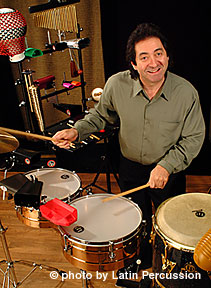"A good drummer listens as much as he plays." ~ Indian Proverb
Percussion Store Drummers Drum Lessons Drumming FAQs
International Shipping
"A good drummer listens as much as he plays." ~ Indian Proverb
Percussion Store Drummers Drum Lessons Drumming FAQs
International Shipping
![]()
![]()
Drums & Percussion
Drum Sets & Cymbals
Cymbals, Hardware & Accessories
Latin Percussion
LP Hardware, Accessories & Replacement Parts
Middle-East Drums & Percussion
African Drums & Accessories
Chinese & Eastern Drums & Percussion
Irish Drums & Percussion
Orchestra Bells & Chimes
Drum & Percussion Hardware
![]()

In the eighteenth century, the European timpani was used in Cuba in the Orquesta Tipica. In the nineteenth century a smaller version of the timpani was introduced and was given the name timbale. In the beginning, the timbale consisted of only two drums on a stand. In the 1930's the small cowbell was added to the set up for use in the more modern rhythm sections of the time. Today the timbale player in a typical rhythm section utilizes larger timbale drums with more accessories attached such as; LP Mambo Bell, LP Cha-cha Bell , LP Wood Block or LP Jam Block and a cymbal on a stand. The job of the timbale player in a Latin band is similar to that of the drummer in a big band. He is responsible for setting up band breaks and driving the band as a trap drummer would. The timbale player plays various parts of the timbale. The Cascara or Paila (shell) the large drum or Hembra, and the small drum or Macho. In the musician's approach, the larger drum serves as a tom tom or bass drum and the small drum serves as a snare drum. Most of the riding is done on the Mambo or Cha-cha bells depending on the rhythm that is being played. The cymbal is used more for punches with the band or accompanying a brass or woodwind solo. The timbale player plays many different types of patterns and these are all based on Son, Rumba or 6/8 Clave. Following are a few examples of the Claves and the basic patterns.
Typical Cascara Patterns in 3-2 clave.
These patterns are generally played with one hand, while the other hand might be playing a counter rhythm on the large timbale or another bell pattern simultaneously. There are many different patterns that are played on timbales which come from the different styles such as Mambo, Mozambique, Charanga, Danzon and Guajira to name a few. Some of the great timbale players known today are Tito Puente, Manny Oquendo, Monchito Monzon, Endel Dueno, Nicky Marrero and Jose Luis Quintana (Changuito), to name just a few. For further information. please refer to Richie Garcia's video, Adventures in Rhythm, Volume 2: Close-Up on Bongos and Timbales, produced by Latin Percussion, Inc and distributed by Warner Brothers. |
Timbales for Sale
Drum Lessons